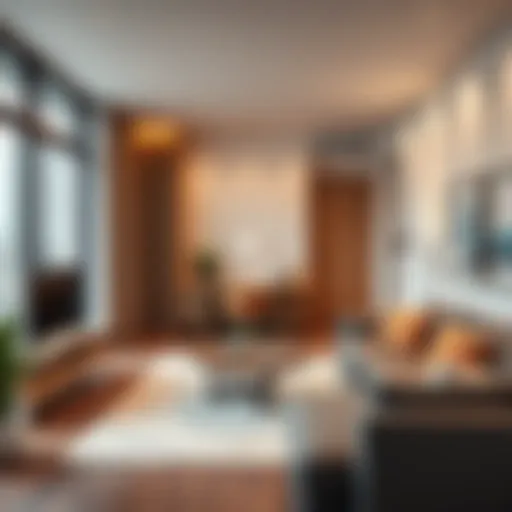Restoring Your Laminate Floor Finish: A Complete Guide
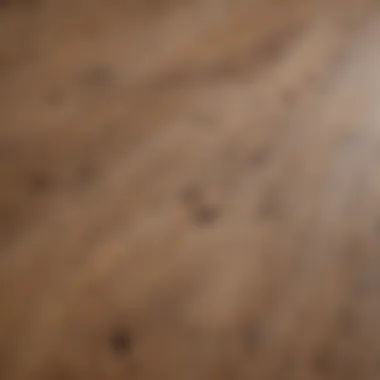

Intro
Restoring laminate flooring is a worthwhile endeavor that can revitalize your home's interior. Whether you've noticed scratches accumulating or the color has faded over time, you may find yourself wondering how to restore those surfaces to their earlier splendor. Laminate floors often fall prey to day-to-day wear and tear, enduring countless scuffs and spills. However, with the right knowledge, tools, and a bit of elbow grease, you can breathe new life into them.
The aim of this guide is to unveil the intricate process of restoring laminate floor finishes and to provide guidance tailored to homeowners and aficionados of interior design. Think of laminate flooring as a canvas; it requires maintenance and care to ensure it remains vibrant and functional. This specialization is not just about cleaning; it's about taking a holistic approach that encompasses not only restoration but also preventive practices that will keep your floors looking pristine for years to come.
In the following sections, you’ll gain insights into effective cleaning methods, advanced repair techniques, and proactive maintenance tips. Each step is crucial, whether it’s dealing with deep-set stains or simple upkeep. The relevance of this restoration process extends beyond aesthetics; it reflects your commitment to maintaining the integrity of your home. With that in mind, let’s explore the various aspects of the restoration process.
Preamble to Laminate Flooring
The conversation around flooring options often glosses over laminate flooring, yet this material holds a unique place in the hearts of many homeowners. As we embark on this guide, it’s crucial to understand why laminate is a preferred choice for so many.
Understanding Laminate Layers
Laminate flooring comprises several layers, each serving a distinct purpose. The top layer, a clear protective coating, shields against scratches and stains, significantly contributing to durability. Beneath that lies a decorative layer, often printed with wood or stone patterns, providing the aesthetic appeal of natural materials without the associated costs.
Here's what you should know about the layers:
- Wear Layer: This is the thin, transparent surface that defends against scuffs and fading. While it seems insignificant, its quality affects the longevity of the floor.
- Design Layer: The visual template of the flooring; advancements in printing technology have made it possible to create realistic textures and patterns.
- Core Layer: Typically made from high-density fiberboard (HDF), it gives strength and stability to the laminate.
- Backing Layer: This layer sits at the bottom, enhancing moisture resistance and providing a smooth surface for installation.
Understanding these layers helps assess what can be repaired and what needs replacement when dealing with wear and tear.
Benefits of Laminate Floors
The allure of laminate flooring goes beyond initial cost savings. Here are some of the notable advantages:
- Affordability: Compared to hardwood or tile, laminate is often more budget-friendly, allowing for substantial savings without compromising on style.
- Variety: With an array of designs, colors, and textures available, homeowners can create personalized spaces. Whether you fancy a rustic oak or a modern grey finish, there's something for everyone.
- Ease of Installation: Laminate flooring often features a click-lock system, making it simpler to install compared to traditional flooring. This not only saves on labor costs but also allows DIY enthusiasts to tackle projects with ease.
- Durability: Given its resistance to stains, fading, and moisture, laminate flooring stands up well in high-traffic areas and homes with kids or pets.
- Low Maintenance: Regular sweeping and occasional mopping will usually suffice to keep laminate looking its best, making it a practical choice for many busy households.
In sum, understanding laminate flooring, its structure, and its benefits is crucial for homeowners eager to restore or maintain their laminate surfaces effectively. This foundational knowledge sets the stage for the detailed discussions that follow in this guide.
Signs of Wear and Damage
Understanding the signs of wear and damage in laminate flooring is crucial for any homeowner or professional interested in maintaining the charm and functionality of their floors. Over time, even the highest quality laminate can show signs of fatigue. Recognizing these indicators early allows for timely interventions that can save you from costly repairs or even full replacements. The importance of spotting issues such as scratches, water damage, and discoloration cannot be overstated; it not only preserves the aesthetic appeal but also helps in creating a safer environment.
There are specific elements one should evaluate regularly. For instance, noticing scratches and scuff marks can indicate heavy foot traffic or the need for better protective measures. Similarly, water damage brings with it a new set of challenges. Recognizing the stains and warping associated with water exposure can help in preventive maintenance. Lastly, fading and discoloration could suggest that the laminate has been exposed to excessive sunlight or harsh cleaning agents. Paying attention to these details is beneficial, as they guide the maintenance routine, ensuring longevity.
Scratches and Scuff Marks
Scratches and scuff marks are often the first visible signs of wear on laminate floors. While they may appear as mere cosmetic flaws, they can indicate more serious issues over time. Small scratches can accumulate if not addressed promptly, leading to a dull appearance that detracts from the entire room’s décor.
To properly manage scratches, it's advisable to routinely inspect flooring, particularly in high-traffic areas. Preventive measures that can minimize scratches include using felt pads under furniture legs and utilizing area rugs in spaces with heavy use. If scratches do occur, there are laminte-specific repair kits available that can mask or even repair these imperfections effectively.
Water Damage Signs
Water damage is a menace that can severely affect the integrity of laminate flooring. Identifying the signs early is essential for any restoration effort. Look out for bubbling, warping, or discoloration, which may suggest that moisture has infiltrated the layers of the laminate.
Prompt attention can often salvage the affected area. For example, if you notice a warped section, isolate the source of moisture—be it from spills, leaks, or high humidity. Once the cause is identified, apply drying methods and check if the laminate can be restored. In some cases, replacing individual planks may be necessary; understanding how to identify this damage can help in mitigating larger issues down the road.
Fading and Discoloration
Fading and discoloration are more subtle signs of wear yet can be equally harmful, especially regarding aesthetic appeal. This could manifest as uneven patches or simply a loss of vibrancy across the surface. The primary causes are sunlight exposure and inappropriate cleaning products, which can break down the protective layers of the laminate.
To combat fading, using curtains, blinds, or UV protective films can prove effective. Regularly cleaning with laminate-safe products will also help in maintaining the finish. It’s worth noting that preventive strategies can save you from needing extensive corrective measures later, making attention to detail essential in maintaining the beauty of your laminate floors.
Essential Tools for Restoration
Restoring laminate floors can feel like trying to solve a puzzle; without the right tools, you might find yourself fumbling around and getting nowhere fast. This section lays out the essential tools that can not only simplify the process but also elevate the final result. Whether you’re tackling minor scratches or significant water damage, having the right instruments on hand is crucial.
Basic Cleaning Supplies
Before diving deep into the restoration process, a clean surface is a must. The foundational cleaning supplies you need include:
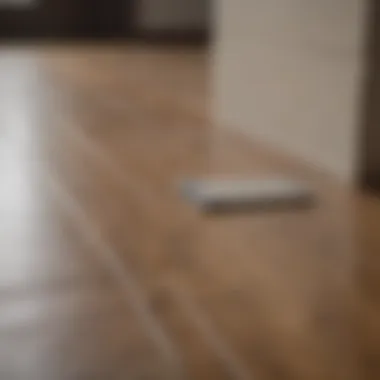

- Broom or Vacuum Cleaner: Keeping the grit off your floor can prevent further damage. A vacuum with a hard floor attachment is ideal.
- Microfiber Mop: This is perfect for a quick damp mop. It won’t scratch the finish and grabs dirt like nobody’s business.
- pH-Balanced Cleaner: Regular cleaners can harsh on laminate, so look for solutions designed specifically for laminate flooring. They’re gentle yet effective.
With these basic supplies, you're halfway there to restoring that shine. It’s worth noting that keeping these on hand can help prolong the life of your floor, sparing you from future extensive repairs.
Specialized Restoration Products
Once the cleaning is done, you might notice more than just dirt. Scrapes, discoloration, and stains can be real party crashers. Here are a few specialized products that can help restore your laminate’s former glory:
- Laminate Floor Repair Kits: These often include wax fillers and color match markers. They’re a go-to tool for minor scratches and can often mask small imperfection.
- Restorative Coatings: Think of these as a facelift for your floor. Available in spray or wipe-on forms, they can rejuvenate the surface and add a protective layer.
As you consider these products, remember the importance of color matching. Not all laminates are created equal; picking the right shade can make all the difference.
Protective Gear
Don't underestimate the need for protective gear while undertaking any restoration project. It’s easy to dismiss it, but a little safety can go a long way. Consider the following:
- Gloves: Keep your hands safe from harsh chemicals and potential abrasives. Opt for nitrile types if you have latex sensitivities.
- Knee Pads: These are invaluable if you’ll be spending a lot of time kneeling down. Protecting your knees can make the experience less painful, allowing you to work longer.
- Safety Glasses: While you might think they’re only for the construction site, safety glasses can protect your eyes from splashes or small debris, making you prepared for anything.
"Investing in the proper tools and products not only boosts effectiveness, but also makes the task significantly more enjoyable."
In essence, gathering your tools correctly might seem trivial, but it sets the stage for a successful restoration. Your laminate is an investment, and protecting that investment with the right supplies pays off in both the short and long term.
Cleaning Laminate Flooring
Proper cleaning is essential to maintain the appearance and longevity of laminate floors. It's more than just about getting rid of dust and dirt; it's about preserving the finish and preventing damage. The right cleaning methods not only ensure that your floors look their best but also help in sustaining their protective layer.
When you neglect cleaning, residue builds up, leading to scratches and dullness. Laminate flooring, while durable, isn't invincible. Regular maintenance can extend its lifespan significantly, allowing homeowners to enjoy their aesthetic appeal over time. Let's dive deeper into effective cleaning strategies.
Routine Cleaning Techniques
Establishing a routine cleaning regimen will keep your laminate flooring in great shape. Here are some straightforward techniques:
- Dust Regularly: Using a microfiber mop or broom is key to make sure dust and dirt don’t scratch the surface. Regular dusting prevents particles from wearing down the finish.
- Use the Right Cleaner: A cleaner specifically designed for laminate floors, such as Bona Laminate Floor Cleaner, helps avoid unwanted residues. Avoid ammonia or vinegar; they can strip the finish over time.
- Damp Mopping: A slightly damp mop, not soaking wet, prevents excess moisture from seeping into seams. Ensure to change water frequently for the best results.
These methods may seem like common sense, but consistency is crucial. A neglected cleaning schedule could spell trouble later.
Identifying and Treating Stains
Stains, unfortunately, are an inevitable part of everyday life on the floor. Recognizing what type of stains you're dealing with can dictate the best approach for treatment. Common types of stains include:
- Food and Beverage Stains: Spills from snacks or drinks should be addressed immediately; they can set if left unattended. Blotting with a gentle cloth and using appropriate cleaners can often do the trick.
- Pet Accidents: Accidents happen. If your pet had a misstep, use enzymatic cleaners that break down the organic material and remove odors effectively.
- Oily or Greasy Stains: These may require a bit more elbow grease. Applying a little dish soap mixed with water can help lift the stain, but make sure to rinse with clean water afterward.
"Immediate attention to stains can prevent permanent discoloration and maintain the integrity of your beautiful laminate floors."
Knowing how to identify and treat stains not only protects your investment but also enhances the overall look of your home. By employing effective cleaning techniques and promptly dealing with stains, you’ll ensure your laminate flooring remains a center of admiration.
Repairing Scratches and Scuffs
Maintaining the aesthetic appeal of laminate flooring is crucial, especially since it’s often less forgiving than other materials when it comes to scratches and scuffs. Repairing these blemishes isn’t just about appearances, though. Addressing scratches promptly can prevent damage from worsening, potentially leading to more significant and costly repairs down the line. Homeowners and enthusiasts alike should pay heed to these minor imperfections, as they can overshadow the floor's overall beauty. Every little nick and scratch tells a story, but that story doesn’t have to be one of decline.
Using Repair Kits
Repair kits are a godsend for people looking to fix scratches and scuffs without breaking the bank. These kits typically come equipped with everything you need to polish over those unsightly marks. When choosing a repair kit, it’s essential to select one that matches your laminate flooring color and texture.
Here’s why using a repair kit can be beneficial:
- Convenience: It's all in one package, making it easier to tackle repairs without gathering various materials.
- Cost-effective: Rather than hiring a professional, a repair kit often saves money while empowering homeowners to do it themselves.
- Precision: Many kits include applicators designed for precision application, allowing for controlled fixes that minimize the risk of over-application.
Be cautious, though. Always read the instructions carefully. A hasty mistake can lead to a repair that sticks out like a sore thumb, rather than blending in seamlessly.
DIY Methods for Minor Scratches
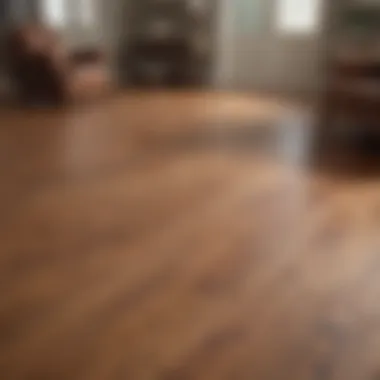

Sometimes, going the DIY route can produce satisfying results for minor scratches. Simple household items can suffice when the damage is relatively light; not every scratch needs professional intervention. Here are some methods worth considering:
- Olive Oil and Vinegar: Mix equal parts of olive oil and vinegar. Dab this mixture on a soft cloth, then gently rub it into the scratch. This method works great on minor blemishes, adding a little shine while masking the damage.
- Crayon or Marker: If the color is off, use a crayon or a permanent marker that matches your laminate. Fill in the scratch carefully and then buff the area with a soft cloth. While this might not be a long-term solution, it can work wonders for a temporary fix when hosting guests.
- Baking Soda Paste: For deeper scratches, create a paste of baking soda and water. Apply it to the affected area and gently rub with a damp cloth. This method not only helps to fill the scratch but can also brighten dull areas around it.
"An ounce of prevention is worth a pound of cure." This adage stands true when it comes to maintaining the beauty of laminate flooring.
Dealing with Water Damage
Water damage can be the bane of any homeowner, especially when it comes to laminate flooring. The importance of addressing this issue cannot be overstated. Moisture can significantly affect the look and durability of your floors, leading to warping, staining, and in extreme cases, complete loss of integrity. Understanding how to deal with water damage is crucial for maintaining the aesthetics and functionality of your laminate surfaces. In essence, managing water exposure and its aftermath can mean the difference between a beautifully maintained home and one suffering from unsightly blemishes and persistent damage.
Identifying Affected Areas
When water makes an uninvited appearance, the first order of business is identifying which sections of your laminate flooring have been compromised. Not all areas are impacted equally; some spots may show clear signs of trouble, while others might be undercover damage just waiting to reveal itself. To pinpoint affected areas, look for:
- Curling edges: If the boards appear to lift at the edges, that’s a strong indicator of moisture intrusion.
- Discoloration: Dark spots, especially near corners or under furniture, often signify water exposure that has seeped into the material.
- Swelling: If sections feel raised or swollen, the cores of the laminate planks might have absorbed moisture.
- Odors: A persistent musty smell can indicate the presence of mold or mildew, both of which thrive in damp environments.
Using a moisture meter can also be a smart move to accurately assess how wet your flooring is and determine the extent of the damage.
Restoration Techniques for Damaged Sections
Restoration techniques for water-damaged laminate floors vary depending on how severe the damage is. Here’s a step-by-step approach to take when diving into repair tasks:
- Drying: The very first step involves thoroughly drying the affected area. Use fans, dehumidifiers, or even natural airflow to eliminate as much moisture as possible. If you can, keep the windows open to promote ventilation.
- Assess Extent of Damage: After drying, take a closer look to see which sections can be salvaged. Sometimes, minor warping may correct itself when dried out.
- Replace Individual Boards: If certain planks are beyond saving and have sustained significant damage, removing and replacing them is often the most effective route. Make sure you have matching boards; if not, you may need to replace more than one to maintain uniformity.
- Applying Sealants: After repairs, consider applying a waterproof sealant to protect your newly restored flooring. This adds a barrier to repel future moisture intrusions, proving invaluable in ongoing maintenance.
- Preventive Measures: Finally, ensure that you’ve implemented measures to prevent future water damage. This could include using area rugs in high-risk spots, sealing cracks in your home’s exterior, or even regulating humidity levels indoors.
"An ounce of prevention is worth a pound of cure." Regular check-ins on your floors can help catch issues before they escalate.
By understanding how to identify areas of water damage and employing these effective restoration techniques, you can maintain the enduring beauty and resilience of your laminate flooring.
Addressing Fading and Discoloration
Fading and discoloration are two of the more common enemies faced by laminate floors, especially in homes that welcome sunlight or foot traffic from pets and children. Addressing these issues isn’t just about aesthetics, it’s about preserving the value of your investment and extending the life of your flooring material. Fluctuations in temperature, exposure to UV rays, and even the cleaning products used can all contribute to gradual color change over time. By understanding how these factors play into laminate upkeep, homeowners can take proactive measures to restore their floors to the vibrancy they once had and maintain that allure for years to come.
Using Laminate Restorative Solutions
When it comes to dealing with fading, laminate restorative solutions can be a game-changer. These products are specifically formulated to bring back the luster of laminate floors that have dulled over time. Typically, they work by adding a layer of shine or color to the existing finish, effectively masking or correcting discoloration. Here’s a peek into some common restorative solutions you might find:
- Refinishers: These are akin to a fresh coat of paint, designed to revitalize tired-looking laminate.
- Polishes: While they don’t necessarily address fading, regular use of polish helps maintain the shine and protects against future wear.
- Color Restorers: For those stubborn patches of discoloration, these targeted products can restore specific hues to match the surrounding laminate more closely.
Always be sure to test any solution in a discreet spot before applying it to the entire floor. You wouldn’t want to discover that your chosen fix makes matters worse!
Preventive Measures Against Discoloration
While restorative solutions can do wonders, prevention is always better than cure. Simple care and maintenance steps can go a long way in keeping your laminate floors looking fresh:
- Use Area Rugs: Place rugs in high-traffic areas and near windows to limit exposure to sunlight.
- UV Blocking Window Treatments: These can significantly reduce UV rays penetrating and fading your floors.
- Choose Appropriate Cleaning Solutions: Avoid harsh chemicals or waxes that can diminish the finish and alter the color.
- Regular Dusting and Cleaning: Keeping dirt and debris off the surface reduces the chance of scratches that can make fading more noticeable.
"An ounce of prevention is worth a pound of cure."
By implementing these preventive measures, you can significantly reduce the likelihood of fading and discoloration, allowing your laminate flooring to shine brighter, longer.
Reapplication of Protective Coatings
Protective coatings serve as a crucial barrier for laminate floors, shielding them from numerous irritants like moisture, dirt, and the regular wear and tear of daily life. Over time, these coatings can wear thin, which leads to a decline in both appearance and durability. Understanding when and how to reapply these coatings can be a game changer in restoring the luster of your floors and prolonging their lifespan.
For many homeowners, failing to reapply protective coatings can result in visible damage, annoyingly frequent cleaning, and in some cases, costly repairs. The process also acts as a refresher, maintaining that pristine look that laminate floors are known for. Ignoring this essential maintenance step could turn your brightly colored, sleek floor into a dull and faded shadow of its former self.
Types of Protective Coatings
When considering the types of protective coatings available for laminate floors, we have several categories to explore:
- Sealants: These are typically clear liquids that seep into the surface, providing a water-resistant layer and making it harder for dirt and stains to penetrate.
- Finishing Products: After cleaning, these coatings add a glossy or matte finish, depending on your preference; they can enhance the depth and richness of the color.
- Wax Coatings: While less common, some users prefer wax products. They provide a classic look but may need more frequent reapplications and maintenance.
- Synthetic Finishes: Used mostly in commercial settings, these coatings are highly durable and intended for high-traffic areas.
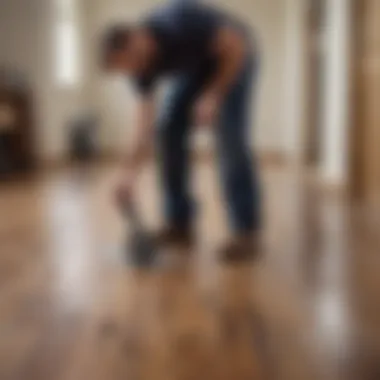

- Example brands: Rejuvenate and Bona offer user-friendly solutions for homeowners.
Taking the time to choose the right type of coating can mean the difference between a floor that needs constant attention and one that remains stunning for years.
Application Techniques for Optimal Results
Proper application techniques play a fundamental role in achieving the desired outcome. Here are key pointers to consider:
- Preparation is Key: Before applying any new coating, ensure that the floor is thoroughly cleaned. Remaining debris or residue can hinder adhesion. Opt for a cleanser that is laminate-friendly to avoid damage.
- Temperature and Humidity: The conditions in the room during application may affect how the coating adheres. Ideally, aim for mild weather conditions—somewhere around 60 to 80 degrees Fahrenheit, with moderate humidity.
- Even Application: Whether using a roller, a mop, or a spray, maintain even pressure. This augments coverage and promotes enhanced bonding. Avoid heavy saturation, as puddling can result in an unwanted finish.
- Layering: In many instances, applying several thin layers can yield better protection than a single thick layer. Allow the coating to dry completely between applications, as this ensures maximum effectiveness.
- Regular Maintenance: After reapplication, continue with regular cleaning and touch-ups as necessary.
"A well-maintained floor is a reflection of a well-maintained home. Take time to care for what supports you every day."
Incorporating these application techniques not only optimizes the longevity of the protective coating but also ensures that your laminate floor maintains its allure.
In summary, reapplication of protective coatings shouldn't be an afterthought but rather a planned part of your laminate flooring maintenance routine. Taking the time to understand different types of coatings and employing effective application methods can transform the vibrancy of your home and extend the life of your flooring.
Long-Term Maintenance Strategies
Maintaining the allure and durability of laminate flooring is not just an afterthought; it's a necessity for preserving its charm over the years. Long-term maintenance strategies ensure that your floors not only look their best but also remain functional for an extended period. By investing time and care now, you can prevent the need for costly repairs later. Moreover, a well-maintained floor significantly enhances the overall aesthetic of your home.
Just like tending to a garden, keeping your laminate floor in tip-top shape requires regular attention and a few smart techniques. Let's explore the key elements that can help you maintain your laminate flooring effectively.
Routine Cleaning Schedules
In the world of laminate floor care, consistency is key. Establishing and sticking to a routine cleaning schedule can make all the difference. Aim for a weekly clean—this will help to keep dust, dirt, and debris at bay. It’s essential to use a dry mop or a vacuum designed for hard floors to avoid scratching the surface.
- Weekly Cleaning Steps:
- Monthly Deep Checks:
- Start with sweeping or vacuuming to remove loose dirt.
- Follow this with a damp mop using a cleaner specifically made for laminate flooring. This will lift any grime without soaking the floor, which is crucial as excess moisture can warp the material.
- Every month, undertake a more thorough inspection. Look for any signs of wear, scratches, or stain build-up that might require special attention.
- If needed, apply a laminate-safe cleaner to spots that require extra care.
By marrying routine with diligence, your laminate floors will not only shimmer but stand the test of time, helping you avoid the all-too-common fate of shadowy scuff marks.
Seasonal Deep Cleaning
When seasons change, it's the perfect opportunity to give your laminate floors a little extra love. Seasonal deep cleaning dives deeper than the routine, addressing accumulated buildup and ensuring that your floor remains vibrant.
- Spring and Fall Cleaning:
- Benefits of Seasonal Cleaning:
- Set aside time to perform a more thorough cleaning routine every six months. This includes not just the floor itself but also the baseboards and any surrounding furniture that may collect dust.
- Use a steam mop specifically designed for laminate; it offers a sanitation boost without causing moisture damage.
- It helps to remove tougher stains and allergens—particularly beneficial for families with pets or kids.
- You’ll be surprised how a simple deep clean can reinvigorate the look of your space.
Remember: Regular deep cleaning prevents small issues from becoming big headaches down the line.
The End
Restoring laminate flooring to its previous glory demands time, care, and a bit of elbow grease. This article encapsulates everything you need to know about restoration practices, maintenance strategies, and more. Real estate enthusiasts, interior design aficionados, and travel lovers alike can benefit greatly from maintaining their laminate floors. A well-kept floor not only enhances the aesthetics but also contributes to the comfort and warmth of a home.
Adopting effective restoration techniques, alongside proactive maintenance, ensures that your laminate surfaces won’t just survive but will thrive for years to come. The intersection of aesthetic appeal and durability culminates in a space that not only looks good, but stands the test of time, proving a worthwhile investment for all.
Summary of Restoration Practices
The restoration of laminate flooring involves a series of systematic steps that can yield remarkable results. Here’s a quick summary:
- Assess the Damage: Start by determining the extent of wear or damage.
- Choose Appropriate Tools: Equip yourself with the right cleaning supplies and specialized restoration products.
- Engage in Rigorous Cleaning: Regular cleaning and spot treatments play a crucial role in maintaining the finish and integrity of the laminate.
- Repair Techniques: Utilize repair kits for minor scratches, or consider DIY methods for deeper marks that need addressing.
- Applying Protective Coatings: Reapply coatings to preserve the floor’s finish and prevent future damage.
- Maintenance Schedule: Implement a routine cleaning and seasonal deep cleaning to keep your floors vibrant.
By undertaking these practices, you’ll not only restore the visual appeal of your floors but also extend their lifespan. Consistent upkeep can safeguard against significant wear that requires intensive repairs.
Encouraging Proactive Maintenance
Preventing damage before it surfaces is the cornerstone of maintaining your laminate flooring. Here are key strategies to keep in mind:
- Regularly Sweep and Mop: A simple but effective routine of sweeping and damp mopping can ward off dust and debris, eliminating scratches.
- Use Doormats: Placing mats at entry points can significantly reduce the amount of dirt and moisture tracked onto the floors.
- Invest in Felt Pads: Placing felt pads under furniture legs minimizes scratches from moving items around.
- Avoid Excessive Water: Laminate is sensitive to moisture, so it is important to dry spills immediately. A damp mop works best over a soaking one.
- Limit Direct Sunlight: UV rays can cause fading. Consider installing curtains or UV films if your flooring is in direct sunlight.
By implementing these measures, homeowners can maintain not just the appearance, but the functional integrity of their laminate flooring for years to come. Proactive maintenance is an investment in peace of mind, ensuring that you can enjoy your space without constant worry about damage.









